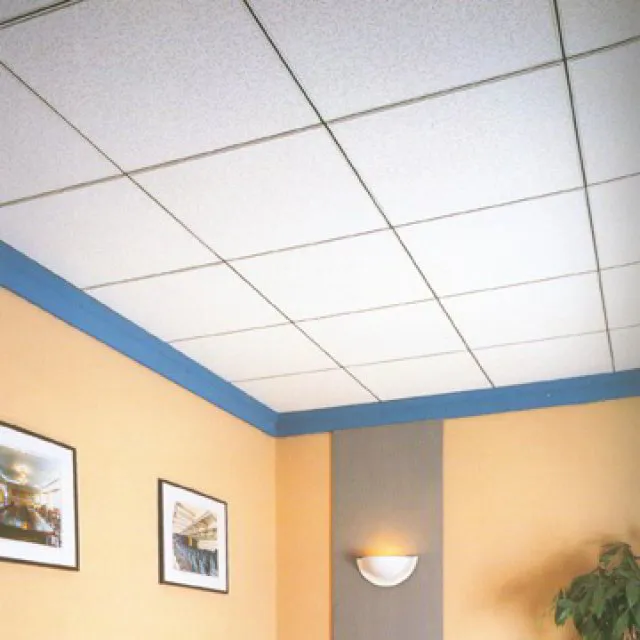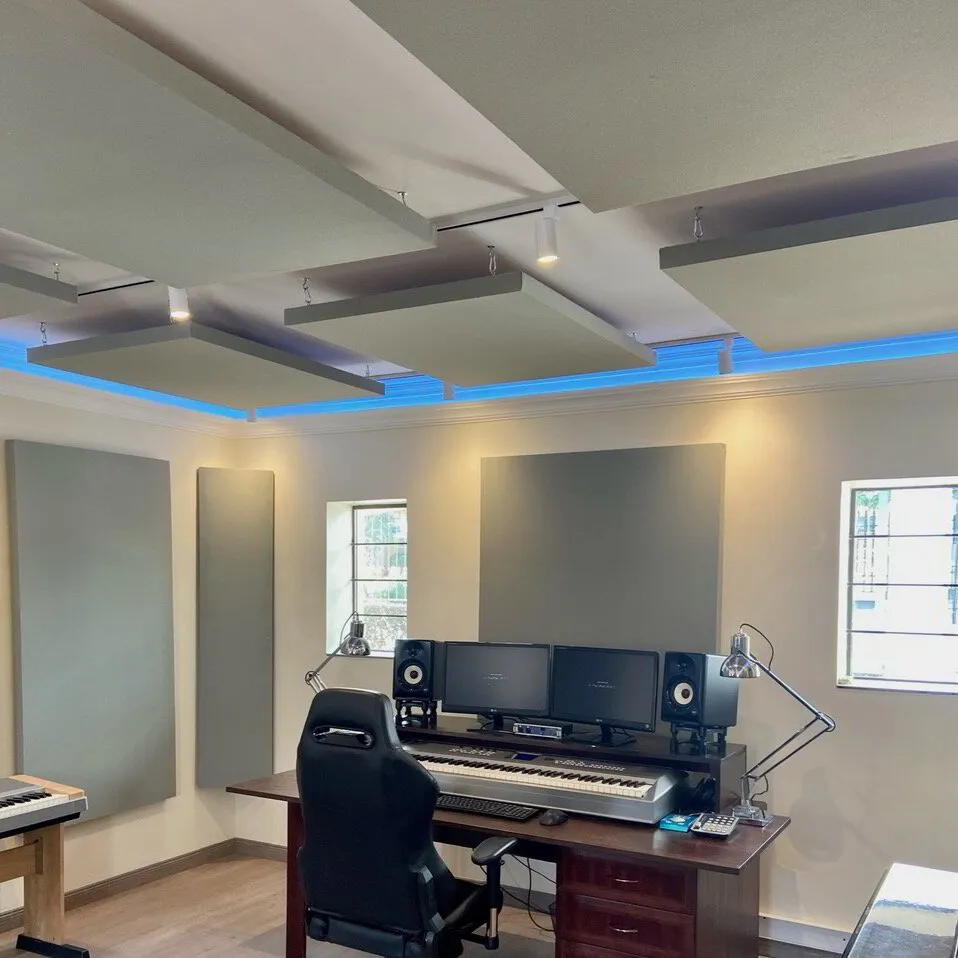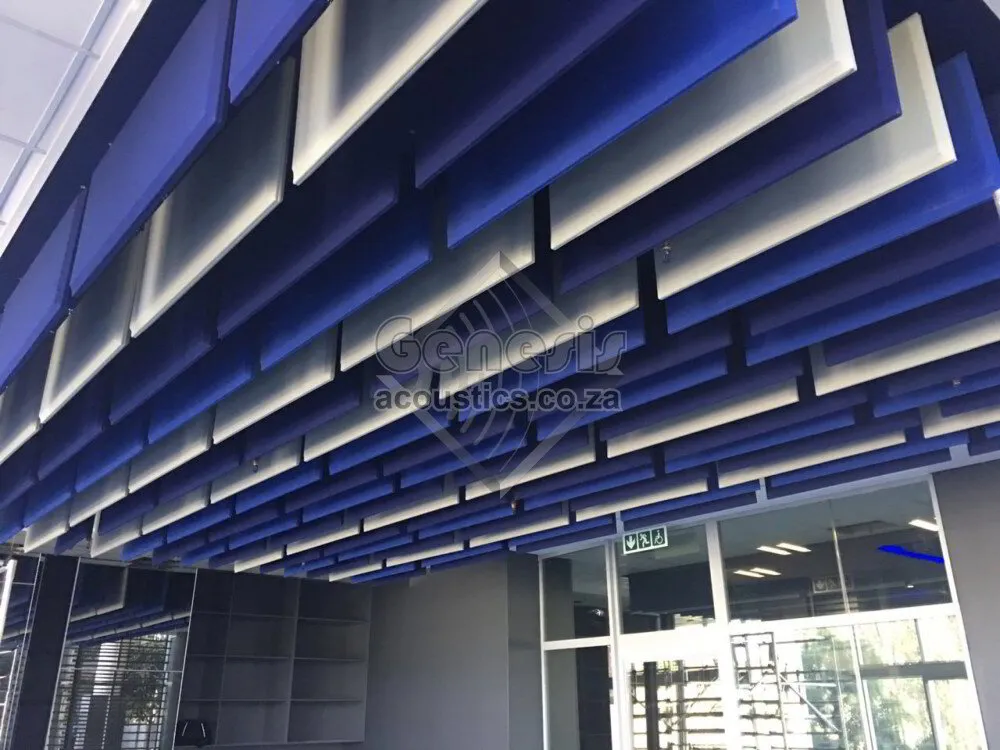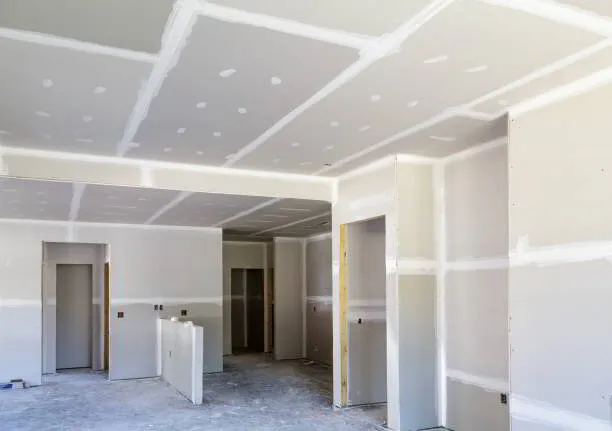Enhance Sound Quality
With An Acoustic Ceiling
Reduce Background Noise & Increase Productivity
Table of Contents
Understanding Acoustic Ceilings
In today’s hectic and noisy world, creating a calm and peaceful environment is essential to our health and well-being. Whether it’s in a commercial or residential space, sound control plays a crucial role in ensuring comfort and productivity.
An effective way to enhance sound quality in any space is through the use of acoustic ceilings. Acoustic ceilings are designed to absorb sound and reduce noise, resulting in improved acoustics and a more pleasant ambiance.
In this blog, we will explore the various benefits and features of acoustic ceilings, helping you understand how they can transform any space into a tranquil sanctuary.
Acoustic ceilings are specially designed to control sound within a room. They work to reduce noise, reverberation and echo, effectively enhancing the sound quality. By absorbing sound waves, they mitigate or completely prevent sound from bouncing off ceilings, creating a more balanced and comfortable acoustic environment.
These ceilings are widely used in spaces such as offices, schools, hospitals, restaurants, and even homes. Whether it be homes or work spaces, noise reduction and good sound quality are important considerations.
Function of an Acoustic Ceiling
The primary function of a sound absorbing ceiling is to control the sound within a space. They reduce the reverberation time and ambient noise levels, thereby improving speech intelligibility, communication and sound clarity. Moreover, they contribute to a peaceful environment, promoting concentration, productivity, and comfort.
Acoustic ceilings work by absorbing the sound waves that cause echo. Sound within a room is reflected off of hard surfaces such as walls, floors, glass and counter tops and the numerous reflections degrade the sound quality. A sound absorbing ceiling helps create a more controlled acoustic environment, where speech and music are clearer, background noise is minimised and the overall quality of the sound in the venue is improved.
Importance of Sound Management
Sound management is vital in any space, from offices to classrooms to healthcare facilities.
Acoustic ceilings play a crucial role in sound management, as the ceiling is normally the largest surface area available for acoustic treatment. They effectively control noise levels, reverberation, and echo, ensuring optimal sound quality in any environment. By incorporating acoustic ceiling materials which have a high noise reduction coefficient (NRC), sound absorption is maximised, resulting in a more peaceful and productive atmosphere.
Diffusers are another product used to control sound but are normally only used in highly specialised places such as recording studios and home cinema rooms.
Difference Between Sound Absorption & Soundproofing
While acoustic ceilings and soundproof ceilings share the goal of improving sound control, there are distinct differences between these two mechanisms.
An acoustic ceiling is designed to enhance sound absorption and reduce reverberation, creating a better acoustic environment within a room or space. On the other hand, soundproof ceilings are primarily focused on isolating sound, preventing it from traveling between spaces, and therefore increasing confidentiality and privacy.
Acoustic ceilings prioritise sound absorption and reverberation control, whereas soundproof ceilings focus on sound isolation between adjacent spaces, making them suitable for spaces that require confidentiality and privacy, such as meeting rooms or even complete silence, such as recording studios.
Understanding the purpose and needs of your space will help determine whether an acoustic ceiling or a soundproof ceiling is the best choice for you. It doesn't have to be an "either or" decision, in many spaces an ideal result can only be achieved by a balance of these two mechanisms working together.
Rating Systems for Ceilings
There are industry wide ratings which are helpful when it comes to selecting the right ceiling for your needs. By considering these ratings, individuals can make informed decisions when choosing acoustic ceilings that will effectively ensure the sound quality in their spaces.
dBA
dBA is the abbreviation for Decibels A-weighted. It is a unit of measurement used to quantify the level of sound or noise. The "A" weighting is applied to dB (decibels) in order to mimic the human ear's sensitivity to different frequencies of sound. This weighting system is particularly important when assessing the impact of noise on human comfort because it accounts for the fact that our ears are more sensitive to certain frequencies than others.
NRC
The NRC rating measures the ceiling’s sound absorption properties, indicating the average percentage of sound absorbed by the ceiling rather than being reflected back into the room. A higher NRC rating indicates superior sound absorbing properties. The NRC for acoustic ceilings typically ranges between 0.6 - 1.0, with 1.0 being the highest result achievable.
CAC
The Ceiling Attenuation Class (CAC) rating measures the ceiling's ability to attenuate sound, indicating how much sound is blocked from passing through the ceiling to adjacent rooms. A higher CAC rating signifies better sound insulation.
STC
The Sound Transmission Class (STC) rating measures the ceiling's ability to block airborne sound transmission between spaces. A higher STC rating indicates better sound isolation between rooms. The STC rating can also be applied to various other structures such as walls, doors and windows. Here are some relatable examples, a hollow drywall has an STC32 whereas a plastered single brick wall has an STC40.
RH
The abbreviation RH stands for relative humidity. If the location of the installation is in a coastal area or an area subject to high levels of humidity then this rating will provide peace of mind knowing whether or not the humidity will have any effect on the ceiling.
Contact us
Need help with your project? We're here to chat and get things moving in the right direction.
Different Types of Acoustic Ceilings
Enhancing the sound quality is essential for many reasons such as speech intelligibility, productivity, music quality and lower levels of ambient noise. The great news is that these benefits are absolutely achievable.
There are many products which offer excellent sound absorption. Understanding how sound behaves within a space helps us to know what methods and materials work best to control the sound.
Noise control in commercial buildings, doctor’s rooms, and boardrooms can be achieved with acoustic suspended ceiling tiles, acoustic drop ceiling tiles, acoustic panels and acoustic foam.
Suspended T-Grid System
Acoustic suspended ceiling tiles in a T-grid system are typically available in two sizes: 1200 x 600mm panels and 600 x 600mm tiles. What size ceiling grid do you prefer? We have found the 1200 x 600mm ceiling grid to be more popular but both can look great.
The acoustic panels are available in either white or black finishes. White ceilings contribute to light reflection which is generally preferred for offices, boardrooms and classrooms. Black ceilings are often preferred in venues such as cinemas, theatres, studios and even some churches.
A suspended ceiling in a T-grid system is also often referred to as a drop ceiling.
Gypsum Ceiling Panels vs Acoustic Ceiling Panels
When considering ceiling panels, it's important to note that standard, solid rhinoboard options lack the specialised sound absorbing features found in acoustic suspended ceiling tiles. The clear distinction lies in their ability to control sound, making acoustic suspended panels a great choice for the improvement of room acoustics, with lower ambient noise levels.
Acoustic Foam
Acoustic foam is a great option when a room already has an existing flush board ceiling or an exposed concrete slab. The acoustic foam tiles or panels can be fixed underneath the existing structure. The effect on the sound is immediately noticeable and provides a big improvement.
Note that in terms of the fire safety requirements, polyurethane foams are generally not safe to use under a ceiling but there is a great alternative in a product called Industro-Foam. This product is not a polyurethane foam and has excellent inherent fire safety properties, being classed as difficult to ignite, it's self extinguishing without the addition of any flame retardants.
Industro-Foam is available in white and a light grey. An advantage of this specialised acoustic foam is that the colour runs all the way through the foam and is not sprayed on afterwards. A disadvantage of polyurethane foams is that the colour tends to fade or even yellow with age therefore it becomes necessary to paint the foam to achieve special colours.
Industro-Foam is extremely light weight which makes it easy to install and adds a negligible load to the ceiling. It is available with a beveled edge for a neat appearance.
Acoustic Ceiling Clouds
Acoustic ceiling clouds provide an innovative solution for areas with high ceilings or rooms with no ceiling at all. They are called clouds because they are hung or suspended in a room, at staggered intervals. This is a part of their appeal as they create a sense of depth as opposed to a closed ceiling.
These clouds effectively reduce sound reverberation and improve speech clarity, creating defined zones of acoustic control within large spaces. Additionally, they add a visually striking element while enhancing sound quality.
Whether it's in commercial buildings, churches, board rooms or restaurants, acoustic ceiling clouds improve noise control and overall sound quality.
Acoustic Baffles
Acoustic baffles are another practical sound absorption solution for spaces with no ceiling or a high ceiling.
Baffles differ from clouds because clouds are hung parallel to the ground whereas baffles are hung from their edge & hang vertically.
They effectively control noise and the way sound travels, making them a great choice for various settings such as reception areas, factories, sports halls, meeting rooms and commercial buildings.
Contact us
Need help with your project? We're here to chat and get things moving in the right direction.
Choosing the Right Acoustic Ceiling for Your Space
Considering the existing structure of your roof & ceiling is crucial when choosing the type of acoustic ceiling that will work best for you.
The colour, design and texture play a significant role in enhancing the aesthetics of your space.
Soundproofing is another essential element of noise control, especially in commercial buildings where sound transmission between adjacent spaces could be a problem.
Thermal insulation is also an important consideration.
Different products and systems offer different benefits, so it's import to speak with an expert who understands your needs.
Acoustic Boards
When the objective is to install a soundproof ceiling then acoustic boards are an excellent option. They can be used to build a solid, continuous, wall to wall ceiling.
Acoustic boards are typically 2.7m x 1.2m x 12mm thick, are butt joined and once fixed in place, all the gaps between the boards are properly sealed.
Plaster / Skimming
Once the boards are secured to the framing then either the joins alone are skimmed or the entire ceiling is skimmed, to achieve a smooth, continuous finish.
MLV Mass Loaded Vinyl
Depending on the desired level of soundproofing required, a layer of mass loaded vinyl (MLV) can be used above the board. MLV is only 3mm thick but can significantly improve the sound isolation of light weight building structures such as drywalls and ceilings.
Acoustic Insulation
Acoustic insulation is an integral part of ceilings which requires acoustic properties or soundproofing. The thickness and density of the insulation plays an important role in the end result. A consultant can advise you according to your specific needs.
Gypsum / Normal Drywall Board
You might be wondering if it's possible to simply use rhinoboard board to construct the ceiling? This is of course common practice when the ceiling does not have a specific soundproofing requirement and in these situations a 6 - 9mm gypsum board is commonly used. However, tests show that regular gypsum board simply does not have the same sound attenuation properties as an acoustic board. It's best to use the right product for the right application.
Contact us
Need help with your project? We're here to chat and get things moving in the right direction.
Sound Insulation vs Thermal Insulation
Let's consider what the terms "sound insulation" and "thermal insulation" mean and the benefits they provide.
Enhancing the usability and comfort within a space involves considering both sound insulation and thermal insulation. Most people are already aware of the need for and the value of thermal insulation to control the indoor temperature.
Effective sound insulation minimises sound transmission between adjacent rooms, ensuring rooms that are quiet and free from outside distractions. Additionally, the dual functionality of sound insulation and thermal insulation in acoustic ceilings contributes to enhancing indoor acoustic and thermal comfort.
Low, Medium or High Density Insulation?
When it comes to acoustic ceiling systems, there are many options including low, medium, or high-density insulation. A low density such as Aerolite insulation, may work well for purposes of thermal insulation but have little to zero value as an acoustic insulation.
Density and mass are important factors which help attenuate sound. Different density options allow you to meet specific sound attenuation and absorption requirements.
The choice of insulation density will affect both the cost and acoustic performance of your space. Speak with an expert to learn more about what will work best for you.
Contact us
Need help with your project? We're here to chat and get things moving in the right direction.
A Comprehensive Soundproofing Strategy
It's all very good and well to install an acoustic ceiling but if you don't also plan the rest of the room structures well then you could end up with a disappointing result. Why? Well much sound travels via other paths. Sounds that arrives via an indirect path is known as flanking sound.
As each of the following deserve a full article - I won't go into any detail here but you can follow the links below to learn more.
List of room elements that should be soundproofed:
Cost of Installation
Estimating the budget of an acoustic ceiling installation is crucial for planning effectively.
Various factors, such as ceiling type, thickness, and the acoustic properties required all influence the overall cost.
The complexity of the installation will also affect the cost.
Understanding these elements and speaking to a professional helps in making informed decisions.
Contact us
Need help with your project? We're here to chat and get things moving in the right direction.
Frequently Asked Questions
What are the benefits of using acoustic ceiling tiles?
Enhancing sound quality in any space, acoustic ceiling tiles offer numerous benefits. They reduce noise and echo, thus improving acoustics. Additionally, they provide insulation, saving on energy costs. Available in various materials and designs, they can be customized to fit any space. Easy to install and maintain, they are a cost-effective solution for improving sound quality.
How do acoustic ceiling tiles improve sound quality in a room?
Acoustic ceiling tiles enhance sound quality by absorbing sound waves, reducing the noise and echoes which degrade sound quality. The porous construction of these tiles traps sound waves, improving speech clarity and reducing noise levels. With various finishes, thicknesses and densities available, acoustic tiles can meet the acoustic needs of many different types of spaces.
Can acoustic ceiling tiles be used in residential spaces or just commercial spaces?
Acoustic ceiling tiles are versatile and can be used in both homes and commercial venues. In homes, they are great for reducing noise from adjoining rooms and enhancing sound quality. They are especially beneficial in home cinema, music, gaming, and entertainment rooms.
What types of materials are commonly used in acoustic ceilings?
Commonly used materials in acoustic ceilings include mineral fiber, glasswool, rock wool and acoustic foams. Some ceilings use perforated metal or slatted wooden panels which create a certain aesthetic. The choice of material depends on factors like the acoustic performance required and the desired appearance.
Can an acoustic ceiling be installed in any type of building or space?
Acoustic ceilings are versatile and can be installed in various types of buildings and spaces. They are commonly used in commercial areas like offices, schools, churches, movie theaters, airports and public spaces. Additionally, they can also enhance the sound quality in homes, particularly in rooms like home cinemas, music rooms, entertainment areas, and studies.
Customer Testimonial
"We contacted Genesis regarding a sound proofing issue we needed to resolve. we needed to soundproof a drywall between two semi-detached dwelling units, as well as soundproof the ceiling space.
Andrew guided us through the process to specify the correct products . On the drywall we used double 15mm acoustic boards with acoustic insulation in between and the ceilings we also used a double layer of 15mm acoustic board but with a 200mm void between where we fitted acoustic insulation.
We sealed all the spaces, corners etc. and the final result was better than we expected happy clients. It is so important to consult with specialists - Thanks to the Genesis team. We are now consulting with them on another project."
Cecilia Fraser











